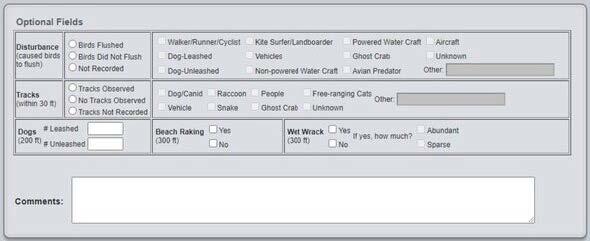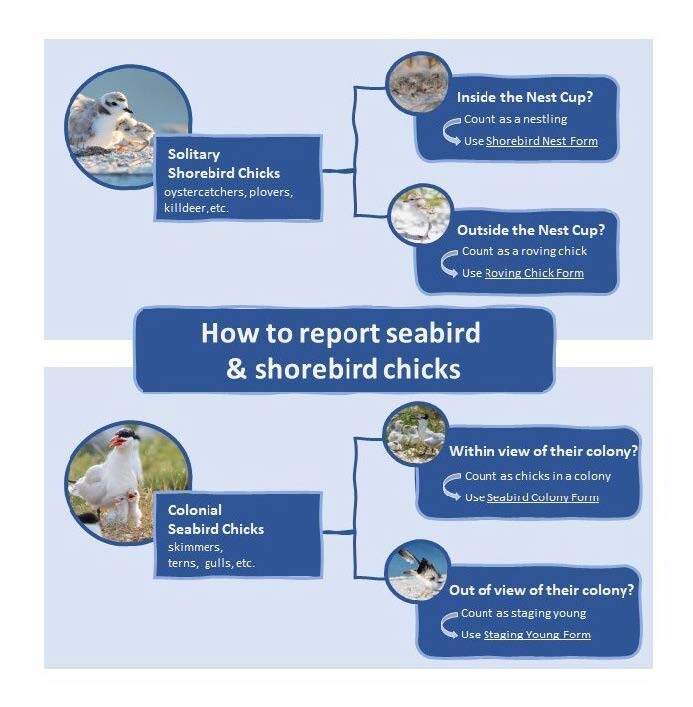|
June 4. 6:30pm. Sarasota County. Virtual training. Please use the following link to join:
https://audubon.zoom.us/meeting/register/tJUldO-trjMtHtbnUhMpa8LzbMC51qXSB42D
June 6. 6:30pm. Pinellas County Skimmers. Virtual training. Use the following link to join:
https://audubon.zoom.us/meeting/register/tJ0ld-mrrzotGtXaYPDs-UiVgpSH4Se5zZSQ
June 10 - 16. June count window for the Breeding Bird Protocol. Whenever possible,
weekly surveys are preferred for routes with active nesting; it helps capture information
about peak counts.
June 12. 6:30pm. Ft. De Soto. Virtual training. Please use the following link to join:
https://audubon.zoom.us/meeting/register/tJMuceyhqDooGdK9SCdEoQMd_tXZZnnkYse4
June 18 - 20. IBNB Permitted Monitor Survey Experience Event. St Johns County; Anastasia State Park and Summer Haven (tentative). For more information, please contact Amanda Hipps.
June 26. 6:30pm. July 4th Holiday (for stewards that will be volunteering during the holiday). Virtual training. Please use the following link to join:
https://audubon.zoom.us/meeting/register/tJAldOCsrTksHtdDNqD_hKy2HeKGy5TPlj4c
June 27. 6:30pm. 3 Rooker. Virtual training. Please use the following link to join:
https://audubon.zoom.us/meeting/register/tJUldemorz8iEtGoKq-BAayTa72u9YzFCm9p
All Summer: Beach stewards are needed at important beach nesting sites. Check out
the Become a Bird Steward opportunities and get involved!
IBNB Permitted Monitor Survey Experience Event
In 2022, the FWC approved new Guidelines for four species of imperiled beach-nesting birds (IBNB): American oystercatchers, snowy plovers, least terns, black skimmers. The Guidelines will take effect on October 1st, 2024. Guidelines clarify protections for the species, provide options for avoiding impacts, and provide information on permitting, including minimization and mitigation options, when impacts are unavoidable.
IBNB Permitted Monitors are trained, dedicated individuals with proven shorebird and seabird identification skills and avian survey experience. They are qualified to assist FWC Incidental Take Permittees with minimizing and avoiding harm or harassment of imperiled beach-nesting birds during project activities.
FWC is pleased to announce that it is hosting an IBNB Permitted Monitor Survey Experience Event. It will be hosted from June 18th to June 20th. People with no survey experience should plan to attend all 3 days as they will each be different. The surveys will likely occur in St. Johns County and may expand to Nassau or Duval Counties, depending on where ground nesting is happening at that time.
Each day will be a new experience, guiding attendees on monitoring imperiled beach-nesting birds to become successful monitors! Please contact Amanda Hipps for more information.
The IBNB Permitted Monitor application is available: please visit the FWC's IBNB Permitted Monitor website and FWC’s permitting website.
Frequently Asked Questions About Highly Pathogenic Avian Influenza
Highly Pathogenic Avian Influenza (HPAI – Strain H5 2.3.4.4) cases have been confirmed in wild birds in Florida. FWC Wildlife Health staff continues to monitor bird mortalities suspected to be attributed to Avian Influenza throughout the state. This strain has been documented in the United States since 2021 and was detected for the first time in Florida in January 2022. Please visit www.myFWC.com/AvianInfluenza for the most updated information.
There is a low risk of HPAI transmission to humans, which can be minimized by following basic safety protocols. To prevent the spread of HPAI, follow the common-sense precautions provided below, which are always recommended to reduce the risk of contracting any disease from wildlife.
Ways to help prevent HPAI spread:
-
Report sick or dead birds so die-offs can be investigated and tested.
- Prevent contact between domestic or captive birds and wild birds (especially waterfowl).
- Do not handle sick or dead wildlife.
- Most wildlife rehabilitation facilities in affected areas are not taking sick waterfowl, waterbirds, raptors, or scavengers (vultures, gulls, crows). Contact the closest rehab facility directly to confirm what their current policy is.
- Look for additional precautions below if you are working around areas where seabirds and shorebirds congregate.
Frequently Asked Questions from Florida Shorebird Alliance Partners:
I work/volunteer as a chick checker at rooftop nesting colonies. Can I continue to safely re-roof fallen chicks?
Yes, while taking the following precautions to minimize risk of HPAI transmission:
- Working outdoors in a well-ventilated environment is recommended.
- If working around wild birds, such as seabirds and shorebirds, protective gear that can be cleaned or disposed, such as a mask, gloves (rubber, latex or nitrile), boots (preferably rubber), eye protection, and an apron are recommended.
- Wash well after handling any bird (for at least 30 seconds with soap) or use an alcohol-based hand sanitizer (apply well and allow to dry before touching anything).
- Between re-roofing each individual chick, clean equipment with sanitizing spray (10% bleach solution) or other bird-safe disinfectant (allow to dry after wiping down).
- Ensure clothes and especially boots/shoes are clean and free of fecal material before leaving the site. Disposable boot covers are recommended if shoes cannot be cleaned.
- Do not eat, drink, or smoke while working around birds.
- If bagging dead chicks for disposal, avoid aerosols from the bag when closing/sealing.
- Any birds collected from a site for disposal should be double-bagged, sealed well, and the outside of the bag disinfected before disposing.
- Carcasses may be disposed by burial, incineration (e.g. pet cremation [double-bagged]), or double-bagged and disposed of at a class 1 landfill or household trash.
- Avoid transporting birds in the interior of cars, and don’t store carcasses in coolers, refrigerators or freezers used for food.
I monitor a bird colony during the breeding season, or regularly conduct surveys of breeding birds in Florida. What precautions should I take?
- Working outdoors in a well-ventilated environment is recommended.
- Ensure clothes and especially boots/shoes are clean and free of fecal material before entering and leaving a site. Disposable boot covers are recommended if shoes cannot be cleaned.
- Do not eat, drink, or smoke while working around birds.
- If working in proximity to wild birds, protective gear that can be cleaned or disposed, such as a mask, gloves (rubber, latex or nitrile), boots (preferably rubber), eye protection, and an apron are recommended.
-
Report observations of sick or dead birds to the FWC avian mortality surveillance site. Sick or dead birds observed in colonies of imperiled beach-nesting birds should also be reported to the FWC Regional Conservation Biologist or Shorebird Program Coordinator, in addition to submitting a report online.
What should I do if observe an injured or entangled bird?
- FWC recommends that people avoid handling sick or dead birds. If you must handle an injured or entangled bird, work in a well-ventilated environment, wear disposable gloves, a mask, and shoes or boots that can be cleaned (preferably rubber). Wash well (for at least 30 seconds with soap) after handling any bird or use an alcohol-based hand sanitizer (apply well and allow to dry before touching anything).
- Clean clothes and shoes or boots to ensure they are free of fecal material. Disposable boot covers are recommended if shoes cannot be cleaned.
- Clean equipment with a sanitizing spray (10% bleach solution) or other bird-safe disinfectant (allow to dry after wiping down).
- Be sure to contact the closest licensed and permitted wildlife rehabber prior to collecting a bird for transport to confirm current protocols for taking in new patient.
I work in an area where HPAI cases have been confirmed, or sick or dead birds are being observed in the area where I’m working. Are there extra precautions I should take?
-
Report observations of sick or dead birds to the FWC avian mortality surveillance site. Sick or dead birds observed in colonies of imperiled beach-nesting birds should also be reported to the FWC Regional Conservation Biologist or Shorebird Program Coordinator, in addition to submitting a report online.
- Working outdoors in a well-ventilated environment is recommended. Do not eat, drink, or smoke while working around birds.
- Ensure clothes and especially boots/shoes are clean and free of fecal material before moving between sites. Disposable boot covers are recommended if shoes cannot be cleaned.
- If working in proximity to wild birds, protective gear that can be cleaned or disposed, such as a mask, gloves (rubber, latex, or nitrile), boots (preferably rubber), eye protection, and an apron are recommended.
- If you drive a vehicle or ATV through a potentially contaminated area (e.g., on beach with carcasses), clean the vehicle well (go to nearest car wash) before or immediately after leaving the area.
- If possible, do not handle sick or dead birds if you have pet birds or poultry at home.
- Do not visit a facility with poultry or captive birds within 72 hours of handling sick or dead birds.

Data Entry Tips - Optional Fields
Do you use the “Optional Fields” in the Florida Shorebird Database (FSD)? These fields are used to document threats and disturbances observed near nests, colonies or chicks. Shorebirds share valuable coastline habitat with people and other animals and sometimes these diverse beach users do not exist harmoniously together, leading to conflicts – an off-leash dog chases a flock of juvenile black skimmers resting on a sand bar or a ghost crab steals eggs from a snowy plover nest. You can use the “Optional Fields” to report these and other disturbances in the FSD, which helps inform local and statewide management strategies to provide better protection for the birds.
The first set of fields deals with disturbance – Did the birds flush? What was the cause? The second set deals with tracks – Did you see any tracks nearby? Can you identify what made them? You can document disturbances and tracks by either selecting from the listed options or by using the “Other” text box to write in a different option. If none of the disturbance or track fields are filled out, the FSD automatically assigns “not recorded”. You can use the last set of fields to document if there was beach raking nearby and if any wet wrack was present.
Don’t forget to use the comment section to provide further explanation of what you observed! Reporting “tracks observed” and “ghost crab” provides the basic information of what and who, but adding comments provides the context. Without comments, all we know is that ghost crabs are in the area. But if comments are included, then we know that “ghost crab tracks were observed in and around nest bowl, and one egg was missing”.
As always, we are happy to answer any questions about documenting disturbances or other data entry quandaries. Email us at FLShorebirdDatabase@myFWC.com!

Chick Data Reminder
Shorebird and seabird chicks are hatching all over the state! These chicks are on the move, and we want to know where they are going! How you report chick data in the Florida Shorebird Database (FSD) varies by species.
Seabird chicks are not very mobile and are dependent on their parents for food, so young chicks (downy, feathered, and some flight-capable) will remain in or very near their colony. These chicks should be counted as part of their colony using the Seabird Colony Form. Flight-capable seabird chicks will eventually start to venture further and further away from their colony. These chicks should be documented using the Roving Chick/Staging Young Form.
Shorebird chicks are very mobile and typically leave their nest shortly after hatching. Any shorebird chick (regardless of age) observed outside of their nest cup should be documented as a roving chick using the Roving Chick/Staging Young Form. Any downy chicks observed inside the nest cup should be documented as nestlings on the Shorebird Nest Form.
Check out the FSA’s shorebird and seabird Aging Guides for help identifying chick ages. As always, we are happy to answer any questions about chick observations or other data entry quandaries. Email us at FLShorebirdDatabase@MyFWC.com!

|